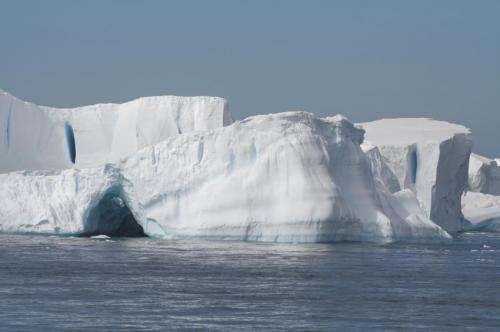Antarctic seawater temperatures rising

The temperature of the seawater around Antarctica is rising according to new research from the University of East Anglia.
New research published today in the journal Science shows how shallow shelf seas of West Antarctica have warmed over the last 50 years.
The international research team say that this has accelerated the melting and sliding of glaciers in the area, and that there is no indication that this trend will reverse.
It also reveals that other Antarctic areas, which have not yet started to melt, could experience melting for the first time with consequences for sea-level rise.
Scientists looked at data from oceanographic records dating back to 1960, and found that temperatures in the West Antarctic Amundsen Sea and the Bellingshausen Sea have been rising.
Prof Karen Heywood, from UEA's Centre for Ocean and Atmospheric Sciences, said: "The Antarctic ice sheet is a giant water reservoir. The ice cap on the southern continent is on average 2,100 metres thick and contains about 70 percent of the world's fresh water. If this ice mass were to melt completely, it could raise the global sea level by 60 metres. That not going to happen, but it gives you an idea of how much water is stored there."
"Accelerated glacial melting in this area has been observed for some time, causing a major contribution to rising sea levels worldwide. We have shown how oceanographic changes over the last half century are likely to have caused this melting."
For example, the temperatures of the warmest waters near the sea bed in the Bellingshausen sea have warmed from about 0.8C in the 1970s to about 1.2C in the 2010s. "This might not sound like much", says the lead author of the study Sunke Schmidtko from GEOMAR in Germany, "but it is a large amount of extra heat available to melt the ice".
The water around Antarctica is also shown to be getting less salty, which is consistent with more ice melting from the Antarctic continent.
The research reveals that more warm water is being transported towards the ice. This accelerates the melting of glaciers from below and triggers the sliding of big glaciers towards the sea.
Antarctica is a cold island in the middle of a relatively warm ocean. The research has shown that the warm water in the deep ocean is getting shallower in many places around Antarctica. This means that it is easier for this warm water to get close to the ice shelves by reaching the shallow seas around Antarctica.
The southwestern Weddell Sea is a colder area where a large-scale melting of ice has not yet happened - and is one of the areas where this warm deep water is getting closer. Professor Heywood explains "Although many of the large ice shelves buttressing the Antarctic ice sheet are not yet melting, the source of warm water seems to be getting closer, so these ice shelves could begin to melt in future which is worrying in terms of global sea level rise."
There are other implications of higher seawater temperatures around Antarctica. Ocean biodiversity could also be affected - for example the spawning cycles of Antarctic krill, which play a key role in the Antarctic food chain, could change in warmer conditions.
More information: 'Multidecadal warming of Antarctic waters' is published in Science on December 5, 2014: www.sciencemag.org/lookup/doi/ … 1126/science.1256117
Journal information: Science
Provided by University of East Anglia


















